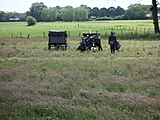
The 7.5 cm Infanteriegeschütz 37 was an infantry support gun, used by Germany during World War II. The guns were originally designated 7.5 cm PaK 37. The IG 37s were manufactured, beginning in late 1944, from carriages of 3.7 cm Pak 36s and a barrel designed originally for the IG 42 infantry support gun. As an anti-tank weapon it used a hollow charge shell with 0.5 kg of explosives to penetrate up to 85 mm (3.3 in) with a velocity of 395 m/s (1,300 ft/s). The first 84 guns were delivered in June 1944. By the end of the war 1,304 guns were operational.
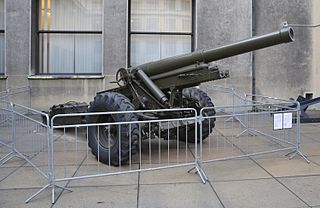
The Škoda 149 mm K series was a line of heavy howitzer designs that served with Germany, Turkey, Romania, Slovakia, and Yugoslavia during World War II.
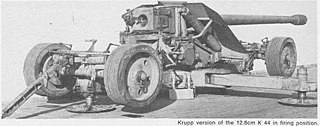
The 12.8 cm Pak 44 was a German anti-tank gun used during World War II. It was designed as a result of experiences on the Eastern front in 1943. The German Army came upon the Soviet 122 mm field guns and issued a requirement for a similar weapon. Development initially concentrated on a field gun known as the Kanone K 44. However, once heavier Soviet tanks such as the IS-2 started to appear, the design requirements were altered to include an anti-armour role.
The 7.5 cm Infanteriegeschütz 42 was an infantry support gun, used by Germany, during World War II. The requirement for this weapon came out of combat experience in 1940 when the existing IG 18 was felt to be outdated.
The 7.5 cm Feldkanone 38 was a field gun used by Germany and Brazil in World War II. Built by Krupp to satisfy an order by the Brazilian Army some 64 were delivered before the war began. In 1942 the remainder of the order was completed and 80 were delivered to the Heer.

The 10 cm Kanone 17 was a field gun used by Germany in World War I and World War II.

The 10 cm schwere Kanone 18 was a field gun used by Germany in World War II. The German army wanted a new 10.5 cm gun as well as 15 cm howitzer which were to share the same carriage. Guns are heavier than howitzers due to the longer barrel. This also led to the 15 cm sFH 18. As such both weapons had a similar weight and could be carried by a similar carriage. By 1926 Krupp and Rheinmetall had specimen designs, and prototypes were ready by 1930, but was not fielded until 1933–34. Both Krupp and Rheinmetall competed for the development contract, but the Wehrmacht compromised and selected Krupp's carriage to be mated with Rheinmetall's gun.

The 8 cm kanon vz. 30 was a Czech field gun used in World War II. Guns captured after the German invasion of Czechoslovakia in March 1939 were taken into Wehrmacht service as the 8 cm FK 30(t). It was used by a variety of German units during World War II, including I./SS-Artillerie-Abteilung 3 between 1939 and 1940.

The 8 cm Feldkanone M.5 was a field gun used by Austria-Hungary during World War I. It was a conventional design, with its most notable feature being its obsolescent autofrettaged bronze barrel, necessary because Austria-Hungary still had trouble making steel of the proper quality. Its development was quite prolonged as the Austrians took years to decide on the proper recoil system and type of breech. Even then production difficulties prevented its introduction into service until 1907.
The Bofors 12 cm M. 14 was a howitzer used by the Netherlands in World War II as the Lichte Houwitzer 12 cm L 14. Captured guns were given a German designation after the Battle of the Netherlands as the 12 cm leFH 373(h) although it is not certain that they were actually used by German forces.

The Bofors 75 mm Model 1934 was a mountain gun produced in Sweden by Bofors and sold abroad widely. The Model 1934 was used by Germany, Belgium, the Netherlands and China in World War II. Germany bought a small number of guns (12) for evaluation and training before the war and designated them as the 7.5 cm Gebirgshaubitze 34. Belgian guns, known by them as the Canon de 75 mle 1934, captured by Germany were designated as 7.5 cm Gebirgskanone 228(b). The later model 1936 was purchased by Bulgaria.
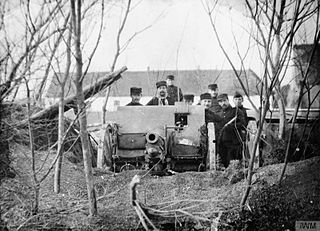
The Canon de 75 mle TR was a field gun used by Belgium during World War I and World War II. It was a license-built copy of the Krupp 7.5 cm Model 1903. Production continued during World War I until the Germans overran the factory in 1914. After 1940, the Wehrmacht designated this as the 7.5 cm FK 235(b), armed occupation forces in Belgium with them and handed some over to the Hungarians.
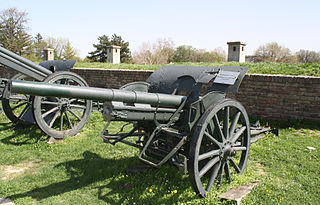
The Canon de 75 mle GPIII was a field gun used by Belgium during World War II. Cockerill mounted a sleeve in the barrels of ex-German 7.7 cm FK 16 guns received as reparations after World War I to convert them to the standard Belgian 75mm ammunition. After 1940, the Wehrmacht designated captured guns as the 7.5 cm FK 236(b). This gun was nearly the equivalent of the German 7.5 cm FK 16 nA and apparently saw wider service than the other captured Belgian guns.

The Krupp 7.5 cm Model 1903 was a field gun used by a number of European armies in both World War I and World War II.

The Cannone da 75/27 modello 06 was a field gun used by Italy during World War I and World War II. It was a license-built copy of the Krupp Kanone M 1906 gun. It had seats for two crewmen attached to the gunshield as was common practice for the period. Captured weapons were designated by the Wehrmacht during World War II as the 7.5 cm Feldkanone 237(i).
The 10.5 cm Cannon Model 1927 was a heavy field gun used by the Netherlands and Hungary during World War II. Dutch guns were known as the 10-veld. Hungary purchased a license and built them as the 31 M. Captured weapons were designated by the Wehrmacht as the schwere 10.5 cm Kanone 335(h). Four were bought by the Swedish Coastal Artillery as the 10.5 cm kanon m/27. They were later upgraded to m/34 standard as the m/27-34. They were transferred to the field artillery in 1942. The Dutch appear to have bought guns with both 40 and 42 caliber barrel lengths.

Bofors 75 mm and Bofors 80 mm were two closely related designs of anti-aircraft and general-purpose artillery. Less well known than the 40 mm quick-firing AA gun, the gun was nevertheless adopted by armed forces of numerous countries during World War II, including Argentina, China, Dutch East Indies, Finland, Greece, Hungary, Persia and Thailand. It was closely related to the 8.8 cm Flak 18/36/37/41, one of the best-known AA guns of World War II, which was partially based on it. Some pieces captured by the Japanese in China served as the blueprint for the Type 4 75 mm AA Gun, a reverse-engineered clone of the Bofors 75mm gun.
The 7.5 cm Flak. L/60 was a German anti-aircraft gun built during the 1930s and used by Germany in limited numbers during the Second World War. Although not produced in great numbers its features were further developed in the 8.8 cm Flak 18/36/37/41 series of guns.
During World War II, Germany maintained comprehensive lists of enemy weapons which were given designations in German in a system that matched that of German weapons. When these weapons were captured and put into use with German forces they were referred to by these designations.
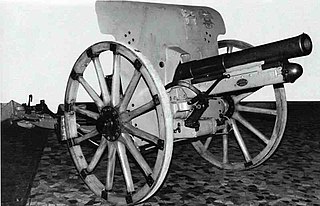
The Cannone da 75/27 modello 1912 cannon was a piece of horse artillery used by the Royal Italian Army during the First World War and Second World Wars. The Germans designated captured guns as the 7.5 cm Feldkanone 245(i).

